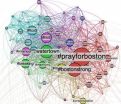(Press-News.org) PITTSBURGH, Mar.14, 2014 – A structured, standardized approach to diagnose and treat sepsis in its early stages did not change survival chances for people who develop this deadly condition, according to a national, randomized clinical trial led by experts at the University of Pittsburgh School of Medicine.
Their findings, available online and published in the May 1 edition of the New England Journal of Medicine, could change the way sepsis is diagnosed and treated. Each year, sepsis, the body's response to severe infections, kills more people than breast cancer, prostate cancer and HIV/AIDS combined.
"We found no overall differences in two protocolized approaches when compared to conventional treatment. The study provides strong evidence that will have immediate consequences," said Derek C. Angus, M.D., M.P.H., Distinguished Professor and Mitchell P. Fink Chair, Department of Critical Care Medicine at Pitt, and investigator of the study. "Many organizations have endorsed structured guidelines for sepsis treatment that often call for invasive devices early in care. But with prompt recognition and treatment of the condition, we found that these approaches do not improve outcomes but do increase the use of hospital resources," said Dr. Angus.
The five-year, multicenter study, called "Protocolized Care for Early Septic Shock" or ProCESS, was sponsored by an $8.4 million grant from the National Institute of General Medical Sciences (NIGMS), part of the National Institutes of Health.
"More than 750,000 cases of severe sepsis and septic shock occur in the U.S. each year, most receiving care initially in an emergency department. We've found that if early recognition and treatment happen, one approach to supporting circulation while giving antibiotics is not better than another," said Donald M. Yealy, M.D., a ProCESS investigator and professor and chair of Pitt's Department of Emergency Medicine.
"ProCESS set out to determine whether a specific protocol would increase the survival rates of people with septic shock. Instead, it showed something far more important—that over the past decade, the care of people with sepsis has significantly improved nationwide," said Sarah Dunsmore, Ph.D., who managed the ProCESS trial for NIGMS. "ProCESS showed that regardless of how the delivery of the interventions was monitored, sepsis patients in these clinical settings are receiving effective treatments."
A 2001 study in a Detroit hospital suggested that early, goal-directed therapy (EGDT), a treatment protocol that includes placing a catheter called a central line in the jugular vein to monitor blood pressure and oxygen levels, as well as delivery of drugs, fluids and blood transfusions according to target levels, reduced mortality by 16 percent.
ProCESS tested whether EGDT was superior to either protocolized standard care (PSC), a simpler strategy that still requires vein access but no central catheter, or the usual care in hospitals across the country, in which the bedside physician directs the course of treatment. All patients in ProCESS were diagnosed quickly and received prompt intravenous antibiotics and fluid resuscitation, but only EGDT required central venous catheterization, sophisticated monitoring and blood transfusions.
Between March 2008 and May 2013, 1,351 patients with septic shock at 31 U.S. hospital emergency departments were enrolled in the trial. They were randomly chosen to receive EGDT, PSC or usual care for the first six hours of resuscitation.
The researchers found no difference in outcomes among the three interventions: at 60 days post-intervention, 21 percent of the EGDT group, 18.2 percent of the PSC group and 18.9 percent of the standard care group had died in the hospital. There were also no differences in mortality after 90 days or one year.
"There have been many improvements in the management of sepsis in the past decade. We examined whether giving the medical team step-by-step instructions to monitor and treat the effects of sepsis could improve survival rates as the previous study suggested," Dr. Angus said. "EGDT, PSC and usual care all offer early diagnosis and methods to deliver fluids, restore blood pressure and monitor cardiovascular function; one was not better than the other to treat the condition effectively." Added Dr. Yealy, "We are not suggesting that sepsis care should be delayed or can be limited."
INFORMATION:
Funding for this research was provided by NIH/NIGMS grant P50 GM076659.
About the University of Pittsburgh Schools of the Health Sciences
The University of Pittsburgh Schools of the Health Sciences include the schools of Medicine, Nursing, Dental Medicine, Pharmacy, Health and Rehabilitation Sciences and the Graduate School of Public Health. The schools serve as the academic partner to the UPMC (University of Pittsburgh Medical Center). Together, their combined mission is to train tomorrow's health care specialists and biomedical scientists, engage in groundbreaking research that will advance understanding of the causes and treatments of disease and participate in the delivery of outstanding patient care. Since 1998, Pitt and its affiliated university faculty have ranked among the top 10 educational institutions in grant support from the National Institutes of Health. For additional information about the Schools of the Health Sciences, please visit http://www.health.pitt.edu.
http://www.upmc.com/media
Pitt study challenges accepted sepsis treatment
2014-03-18
ELSE PRESS RELEASES FROM THIS DATE:
Hold that RT: Much misinformation tweeted after 2013 Boston Marathon bombing
2014-03-18
It takes only a fraction of a second to hit the retweet button on Twitter. But if thousands of people all retweet at once, a piece of information 140 characters long can go viral almost instantly in today's Internet landscape.
If that information is incorrect, especially in a crisis, it's hard for the social media community to gain control and push out accurate information, new research shows.
University of Washington researchers have found that misinformation spread widely on Twitter after the 2013 Boston Marathon bombing despite efforts by users to correct rumors ...
Satellite movie shows a Mid-Atlantic St. Patrick's Day snow
2014-03-18
The green of St. Patrick's Day in the Mid-Atlantic was covered by white snow as a result of a late winter snow storm. The covering of the green was captured in a movie made at NASA using NOAA's GOES satellite data.
The winter storm dropped snow totals from 6" to 12" of snow from Baltimore, Md. to Richmond, Va. The storm arrived during the evening of March 16 and continued through March 17. As of 1 p.m. EDT, light bands of snow continued to fall throughout the Washington, D.C. area.
NOAA's GOES-East satellite captured the path the storm took through the Mid-Atlantic ...
Health gap between adult survivors of childhood cancer and siblings widens with age
2014-03-18
Adult survivors of childhood cancer face significant health problems as they age and are five times more likely than their siblings to develop new cancers, heart and other serious health conditions beyond the age of 35, according to the latest findings from the world's largest study of childhood cancer survivors. St. Jude Children's Research Hospital led the research, results of which appear in the March 17 issue of the Journal of Clinical Oncology.
The federally funded Childhood Cancer Survivor Study (CCSS) found that the health gap between survivors and their siblings ...
'Breaking bad': Insect pests in the making
2014-03-18
Of thousands of known species of Drosophila fruit flies, just one is known as a crop pest, depositing eggs inside ripening fruit so its maggots can feed and grow. New research from the University of California, Davis, shows the similarities and crucial differences between this pest and its close relatives — and that one related fly has potential to also become a pest.
Drosophila flies, found worldwide, lay their eggs in rotting fruit. Drosophila suzukii, also referred to as "spotted-wing Drosophila" because the male has large black blotches on his wings (as do males of ...
UT Arlington information systems professors determine successful software programming aids
2014-03-18
The success of having software programmers work in pairs greatly depends on the ability level of those individual programmers, two UT Arlington College of Business professors have written in a recently released paper.
The paper also concluded that using design patterns can greatly improve the quality of software programs and the productivity of programmers.
Professor Radha Mahapatra and Associate Professor Sridhar Nerur, both in the Information Systems and Operations Management Department of the College of Business, recently published "Distributed Cognition in Software ...
The basis of a new bioinsecticide is developed to control a pest of banana plantations
2014-03-18
Certain micro-organisms can constitute the active matter to develop bioinsecticides used for pest control. In this case, the researcher used a virus of the baculovirus family, which specifically infect invertebrates and naturally regulate the population of insects of this type on the ground. "We selected a virus that displayed the best insecticidal characteristics," she explained. "Using this virus we developed a large-scale production system by means of which we could treat a surface area equivalent to that of a football pitch using just two larvae."
When a larva infected ...
Nanotube composites increase the efficiency of next generation of solar cells
2014-03-18
Carbon nanotubes are becoming increasingly attractive for photovoltaic solar cells as a replacement to silicon. Researchers at Umeå University in Sweden have discovered that controlled placement of the carbon nanotubes into nano-structures produces a huge boost in electronic performance. Their groundbreaking results are published in the prestigious journal Advanced Materials.
Carbon nanotubes, CNTs, are one dimensional nanoscale cylinders made of carbon atoms that possess very unique properties. For example, they have very high tensile strength and exceptional electron ...
Cardiologists define new heart failure symptom: Shortness of breath while bending over
2014-03-18
DALLAS – March 18, 2014 – UT Southwestern Medical Center cardiologists have defined a novel heart failure symptom in advanced heart failure patients: shortness of breath while bending over, such as when putting on shoes.
The condition, which UT Southwestern cardiologists named "bendopnea" (pronounced "bend-op-nee-ah"), is an easily detectable symptom that can help doctors diagnose excessive fluid retention in patients with heart failure, according to the findings published in a recent edition of the Journal of the American College of Cardiology: Heart Failure.
"Some ...
Antimony nanocrystals for batteries
2014-03-18
This news release is available in German.
The hunt is on – for new materials to be used in the next generation of batteries that may one day replace current lithium ion batteries. Today, the latter are commonplace and provide a reliable power source for smartphones, laptops and many other portable electrical devices.
On the one hand, however, electric mobility and stationary electricity storage demand a greater number of more powerful batteries; and the high demand for lithium may eventually lead to a shortage of the raw material. This is why conceptually identical ...
Study of complete RNA collection of fruit fly uncovers unprecedented complexity
2014-03-18
BLOOMINGTON, Ind. -- Scientists from Indiana University are part of a consortium that has described the transcriptome of the fruit fly Drosophila melanogaster in unprecedented detail, identifying thousands of new genes, transcripts and proteins.
In the new work, published Sunday in the journal Nature, scientists studied the transcriptome -- the complete collection of RNAs produced by a genome -- at different stages of development, in diverse tissues, in cells growing in culture, and in flies stressed by environmental contaminants. To do so, they used contemporary sequencing ...








